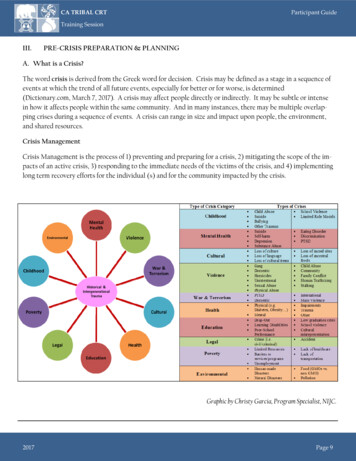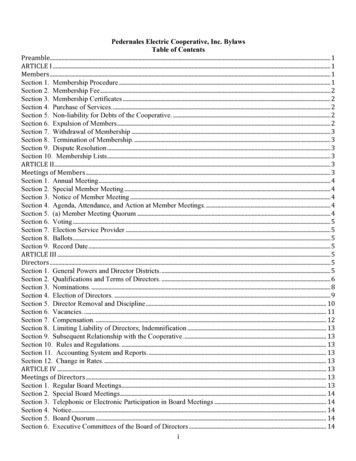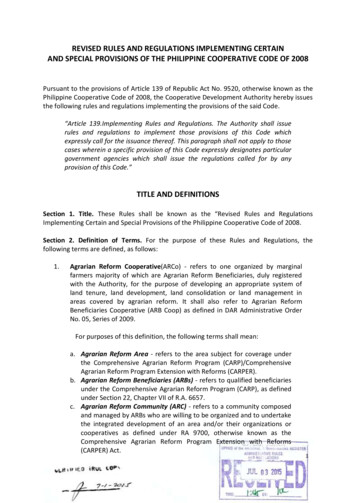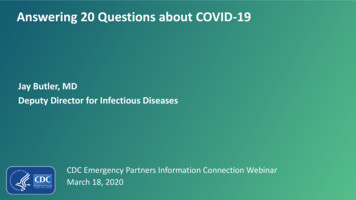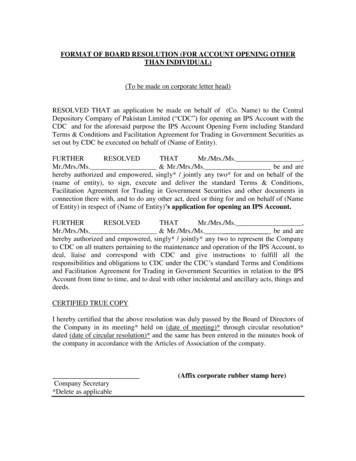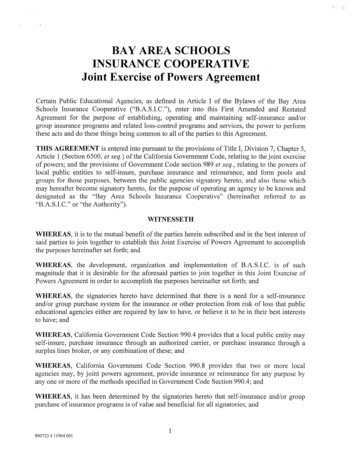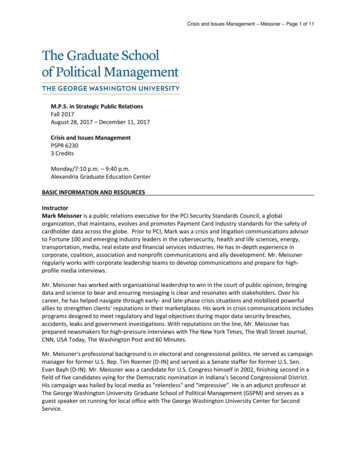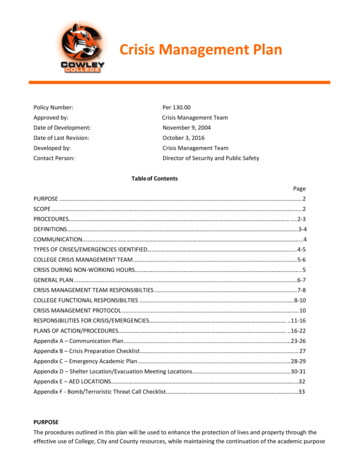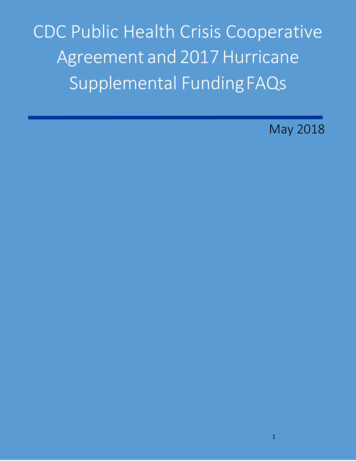
Transcription
CDC Public Health Crisis CooperativeAgreement and 2017 HurricaneSupplemental Funding FAQsMay 20181
Table of ContentsIntroduction .3General Questions: Cooperative Agreement for Emergency Response: Public Health Crisis Response Notice ofFunding Opportunity (NOFO) .42017 Hurricane Recovery Jurisdictional Crisis Cooperative Agreement Questions .7General .7Funding scope.9Staffing.10Facilities and equipment .11Surveillance, tracking, and registry.12Immunization.13Environmental health .13REDCap (research electronic data capture).14General .14Data entry .142
IntroductionIn 2017, CDC (Centers for Disease Control and Prevention) released the CDC-RFA-TP18-1802 CooperativeAgreement for Emergency Response: Public Health Crisis Response notice of funding opportunity (NOFO). Thisfunding mechanism enables CDC to quickly award funds to state, local, tribal, and territorial public healthagencies in the event of a public health emergency. Eligible applicants were the 50 states; eight U.S. territoriesand freely associated states; six localities: Chicago, Houston, Los Angeles County, New York City, Philadelphia,and Washington, D.C.; and federally recognized tribal governments that meet the NOFO requirements andserve, through their own public health infrastructures, at least 50,000 people.The Public Health Crisis Response NOFO established an approved but unfunded (ABU) list of 64 healthdepartments that are eligible for future funding, if an emergency occurs and funding becomes available. CDC willactivate this umbrella cooperative agreement (CoAg) when a public health emergency has occurred or isimminent and funding is available. At that time, CDC will determine whether all or a subset of healthdepartments on the ABU list need to be funded. Factors such as the nature of the specific emergency, diseaseburden (if appropriate), geographic location, health impact, and national priorities will be considered. Recipientswould receive funds to stand up emergency activities, such as activating emergency operations centers,preparing contracts for surge staffing, implementing risk communications activities, and determining crisisspecific resources that will be needed over the course of the response.On February 9, 2018, Congress approved and the President signed into law the Bipartisan Budget Act of 2018,which appropriated 200 million in hurricane funding to CDC to remain available until September 30, 2020. OnMarch 16, 2018, CDC activated the public health crisis response funding mechanism to award a portion of the 200 million the agency will receive for response, recovery, preparation, mitigation, and other expenses directlyrelated to the consequences of Hurricanes Harvey, Irma, and Maria.CDC released on March 30, 2018, the 2017 Hurricane Recovery Crisis Cooperative Agreement interim guidance.The guidance included information related to eligibility, use of funds, permissible activities, reimbursement, andfunding timeframes.3
General Questions: Cooperative Agreement for Emergency Response:Public Health Crisis Response Notice of Funding Opportunity (NOFO)What are the funding restrictions for this NOFO for applicants? The NOFO is designed to support the surge needs of your existing programs resulting from a publichealth emergency. Therefore, applications which seek to create new public health departments oremergency management programs will not be considered.What are the funding restrictions for this NOFO for recipients?Recipients may not use funds for: ResearchClinical care (except as allowed by law)Emergency preparedness activities or capacity buildingNew facility construction or major renovationso Note: Funds may be used to purchase basic (non-motorized) modular structures/trailers withprior approval from CDC.Purchase of vehicleso Note: Funds may be used for leasing vehiclesThe matching of federal funds from other sources or to create overlap in projects, budget items, orcommitment of effort. For example, funds cannot be used for items covered by the Federal EmergencyManagement Agency (FEMA) or other federal funds.The preparation, distribution, or use of any material (publicity/propaganda) or to pay the salary orexpenses of grants, contract recipients, or agents that aim to support or defeat the enactment oflegislation, regulation, administrative action, or executive order proposed or pending before a legislativebody, beyond normal, recognized executive relationships.Furniture or equipment. Any proposed spending must be clearly identified in the budget.Pre-award costs, unless CDC provides written approval to the recipient.The recipient must perform a substantial role in carrying out project outcomes; they may not only serve merelyas a conduit for the award to go to an otherwise ineligible entity.In accordance with the United States Protecting Life in Global Health Assistance policy, foreign nongovernmental organizations that receive funding through this award from the recipient are prohibited fromperforming abortions as a method of family planning and may not provide financial support to any other foreignnon-governmental organization that performs such activities. See Additional Requirement (AR) 35 forapplicability.4
What are the timeline requirements for recipients? Recipients will be capable of activating new or surging current emergency response activities within atwo-day period. According to the general cooperative agreement guidance, a recipient must be capable of the followingwithin 14 days of notice of CDC’s intent to make an award:o Submit an amended budgeto Rapidly procure equipment and services through a General Services Administration (GSA)contract or other mechanismo Contract or hire temporary staffHowever, the period of time allotted for these steps will vary depending on the crisis/response. For thehurricane supplemental funding opportunity, recipients will be given 45 days. Recipients will need to be able to execute a contract within 30 days.Can the jurisdiction/recipient subcontract to a nongovernmental organization?Yes, subcontracting/sub-awarding is allowable.For future disasters, does the applicant initiate a funding request from CDC or wait for CDC to offer?A state can notify CDC of a need, but only CDC can determine whether this cooperative agreement is theappropriate mechanism and identify whether there is funding available.How long do we need to keep cooperative agreement records (electronic or paper)?Recipients must retain records for three years. In general, cooperative agreement project records that should bemaintained include, but are not limited to, cooperative agreement financial records and related documents thatsubstantiate costs charged to the cooperative agreement, such as: the general ledgeraccounting source documentspersonnel and payroll recordstimesheetscancelled checkscooperative agreementSee OMB Circular 2 CFR 215.53 and A-102 § .42 for more details.Who may request these cooperative agreement records?The awarding agency, the agency Inspector General, the Comptroller General of the United States, and any dulyauthorized representatives must be provided access to all recipient records pertinent to the cooperativeagreement to make audits, examinations, transcripts, and copies of these records.What would trigger a final audit of our cooperative agreement records?An audit may occur if the recipient has not been audited in more than a year or because of awarding agencyconcerns that the recipient may not have spent federal funds according to specifications and requirements. Alsonote that an annual budget is a regulatory requirement.5
What would be the outcome if costs were improperly claimed?The awarding agency has the right to disallow costs and recover funds from the recipient, even after cooperativeagreement is closed, if a later audit or other review identifies costs that were improperly claimed and should nothave been allowed.Questionable costs must then go through the agency’s audit resolution process before the recipient is asked torepay any disallowed costs. It is the awarding agency’s responsibility to follow up on any decision to disallowcosts, even after closeout occurs, to ensure that the necessary federal funds (i.e., debt to the federalgovernment) are recovered.See OMB Circular A-102, 2 CFR 215.72, A-133 §.320, and 2 CFR 215.73 for more details.6
2017 Hurricane Recovery Jurisdictional Crisis Cooperative Agreement QuestionsGeneralIs this funding a new NOFO for hurricane relief or it is part of the “NOFO TP18-1802: Cooperative Agreementfor Emergency Response: Public Health Crisis Response” that we were awarded as “approved but unfunded”?This supplemental funding is part of the TP18-1802 NOFO with Congressional appropriations for “response,recovery, preparation, mitigation, and other expenses directly related to the consequences of HurricanesHarvey, Irma, and Maria”.What is the scope of the hurricane funding? Is this funding for expenses incurred during the recent hurricanesor for the next hurricane season?Funding will be allocated for response, recovery, preparation, mitigation, and other expenses directly related tothe consequences of hurricanes Harvey, Irma, and Maria. It is for reconstituting services but can also be used toaddress unmet needs caused by the hurricane’s impact.Can we request reimbursement for hurricane-related expenses that occurred in 2017?Public health expenses that occurred up to 120 hours prior to Hurricanes Harvey, Irma, and/or Maria landfall inyour jurisdiction and prior to the CoAg notice of award are potentially reimbursable. Reimbursable expensesmay include, but are not limited to, activating emergency operations centers (EOCs), reviewing hurricane plans,and coordinating with other agencies. Jurisdictions must submit reimbursement requests through thereimbursable OPHPR jurisdictional disaster immediate reimbursement project plan.How do I apply for this hurricane supplemental funding? Any jurisdictions on the accepted but unfunded (ABU) list should:o Submit a notice of intent to apply to DSLRCrisisCoAg@cdc.gov.o Request access to the hurricane project in the REDCap system by emailingDSLRCrisisCoAg@cdc.gov.o Complete work plans and budget narratives in REDCap within the 45-day timeframe (no laterthan May 14).When can we expect to receive funding?CDC will issue Notices of Award (NOAs) after approving final work plans and budgets. Jurisdictions may receivefunding as early as June, 2018.7
What is the funding ceiling for applications to this hurricane supplemental funding?Funding ceilings are available to jurisdictions and determined by the sponsoring CDC program offices that haveproposed project plans. The funding ceilings are posted in REDCap.Will the guidance for the work plan and budget narrative include the amount a specific jurisdiction is likely toreceive?Each project plan will have its own range of available funding. There is no cumulative ceiling.What do the budget ceiling minimum and maximums mean for activities (e.g., NCEZID rabies project plan hasa range of 250,000 TO 900,000)?This means that jurisdictions should target a budget between 250,000 and 900,000 for this specific project.What is the deadline to submit revised work plans and budgets?Revised work plans and budget narratives are due to be entered in REDCap by May 14, 2018, 11:59 PM.Will the funding received through this mechanism need to be held by a large local organization (e.g., therecipient health department) or could it be distributed to impacted counties/localities?The recipient can determine how to distribute the funds it receives. However, use of the funds must remainwithin the scope of the hurricane funding interim guidance and the CDC program offices proposed project plans.Will we have to track performance according to each of the six domains (biosurveillance, communityresilience, countermeasures and mitigation, incident management, information management, and surgemanagement) separately?Yes, performance measures will likely be tracked by domain, though performance measurements are still beingfinalized. CDC will provide additional guidance once the measures are finalized. It is not a requirement forproject plans to include activities from all six domains. Work plans should only address domains listed in theproject plan.How are performance measures finalized?CDC will work with recipients during the first 90-days post award to finalize performance measures. CDCreserves right to make changes to these performance measures and reporting frequency, pending additionalguidance from CDC, HHS, or Congress.8
If a CIO program project plan has multiple activities, should we include performance measures for eachactivity or can there be two or three overarching performance measures per the CDC program office Projectplan?You have the option to provide overarching performance measures per plan that cover more than one activity.Where can I find information about the Emergency Management Assistance Compact (EMAC)?You can find more information on the EMAC website.If a jurisdiction receives hurricane-related assistance under the EMAC from another jurisdiction, can either thedonating or receiving jurisdiction request funds from this mechanism to reimburse the donating jurisdiction?The receiving jurisdiction may request funding. The donating jurisdiction may not. The receiving jurisdictionwould need to review the initial authorization of the EMAC mission and verify it was not funded through anotherfederal mechanism.Can hurricane funds be used for private organizations like hospitals that deployed staff via EMAC (and weretherefore considered state employees because they signed an MOU) to reimburse travel, salaries, and otherrelated expenses?It is the responsibility of the receiving health department to request funding from this hurricane cooperativeagreement for EMAC reimbursement. The receiving jurisdiction would need to review the initial authorization ofthe EMAC mission and verify that no federal funds supported the EMAC mission.Will funding received through this mechanism affect ongoing post-hurricane projects with CDC divisions?No, this should not have any impact on existing activities. Duplication of activities and supplanting of funds arenot allowed.Can funding be used to support or establish patient tracking?Yes, patient tracking that is related to response or recovery may be funded under this mechanism. For example,vaccine registries or other immunization programs could be an allowable expense if these capabilities wereimpacted by the hurricanes. However, tracking that is related to normal patient care would not be permitted.Can these funds be used to cover costs associated with receiving evacuees from other states?Yes, this type of activity will be considered.9
To what extent can these funds be used for health communications efforts?Funds may be used for health communications expenses associated with response, recovery, preparation,mitigation activities directly related to the consequences of 2017 Hurricanes Harvey, Irma, and Maria.Funding scopeCan we conduct activities based on other hurricanes (e.g., Matthew) or just Harvey, Irma, and Maria?No, any activities you propose must be the direct result of, or directly related to, Hurricanes Harvey, Irma,and/or Maria.What if my activities have already been covered by FEMA or I have an application for funds with FEMA oranother federal funding source?If funding has already been requested through another federal mechanism (Stafford Act, FEMA funding, publicassistance or other funding) to cover an expense, funding cannot also be requested through this mechanism.This funding cannot be used as matching funds for other federal funding requirements.After hurricane landfall, the federal government conducted public health activities in our jurisdiction. Whatare the reimbursable/non-reimbursable response and recovery costs?Activities funded by the federal government in the aftermath of the hurricane(s) is not reimbursable. As anexample, after the hurricane(s), FEMA worked directly with states to conduct emergency activities, includingmosquito abatement. These FEMA supported activities are not eligible for reimbursement.What is the project period for funding? Is there a 90-day close-out period?All funding is required to be obligated within 24 months of the notice of award. This means it needs to be fullyexpended with the 24 month period after CDC awards the funds, unless waived by the Office of Managementand Budget (OMB) at the request of CDC. For more information about this requirement, reviewImplementations of Internal Controls and Grant Expenditures for the Disaster-Related Appropriations from theOMB.StaffingCan CDC deploy staff to provide technical assistance?Yes, CDC may be able to provide technical assistance to jurisdictions. Technical assistance will be decided on acase-by-case basis. Technical assistance should be requested through a CDC program office point of contact forspecific projects.10
Can CDC provide direct assistance or contracting mechanisms to hire staff for our health department usingthis funding?Yes, this hurricane funding mechanism allows direct assistance (DA). You may request federal personnel as DA,in lieu of financial assistance, based on an identified need and pending the availability of funds. DA requestsmust be coordinated between the jurisdiction and CDC program office. However, staff are limited in theduration of their assignments, i.e., 24 months from when the NOA is issued. In cases where DA requires newstaff hired through the federal process, staff may not be available for the full funding period. Jurisdictions areencouraged to communicate their staffing needs to their CDC program office point of contact.How does direct assistance from CDC affect awarded funds?If a grant or cooperative agreement recipient requests that CDC provide direct assistance (supplies or staffing),then it may reduce the amount of such grant or cooperative agreement by1) the fair market value of any supplies (including vaccines and other preventive agents) or equipmentfurnished to the grant or cooperative agreement recipient, and2) the amount of the pay, allowances, and travel expenses of any officer or employee of thegovernment when detailed to the grant or cooperative agreement recipient and the amount of anyother costs incurred in connection with detail of such officer or employee.Can funds dispersed through this cooperative agreement be used to cover resource costs, such as those costsincurred to send nurses and other staff to support shelters that were impacted by the hurricanes?Yes, cooperative agreement funds can be used to cover such expenses, but only If reimbursement cannot berequested through another federal mechanism (Stafford Act, FEMA funding, public assistance or other funding).Facilities and equipmentCan funds be used for the construction or reconstruction of health or public health facilities?These funds cannot be allocated for basic construction. The expectation is that FEMA will fund reconstruction.These funds are not allowed to match any funds for construction or reconstruction of health departments orhealth care facilities. It may be feasible to use these funds to provide temporary, modular facilities like trailers.Can funds be used to rent cubicle space?Yes, funds can be used to rent or lease cubicle or office space to conduct health department functions.Can funds be used to purchase vehicles?No, funds cannot be used to purchase vehicles. Funds can be used to lease vehicles. Click here for a linkspecifically for leasing a GSA vehicle for disaster relief, including contracts and a list of vendors.11
Where in the work plans do we put requests for leasing vehicles?You can put a request for leasing a vehicle in any related work plan. For example, if the leased vehicle is forvaccine distribution, it can be placed in a NCIRD work plan; if it is to be used for overall management oradministration of the cooperative agreement, it could be placed in OPHPR’s “Reconstitution ManagementFunding” plan.Is storage of documents an allowable cost?Yes. Storage costs for rehousing documents and other critical items put at risk by the 2017 hurricanes thatmust be saved would be reasonable costs.Surveillance, tracking, and registryCould this funding be used to improve our active or future surveillance?These funds are for response, recovery, preparation, mitigation, and other expenses directly related to theconsequences of Hurricanes Harvey, Irma, and Maria. If surveillance activities are associated with the impacts ofthe 2017 hurricane season, then funds could be provided.Can we support syndromic surveillance projects based on what we learned from the hurricanes?Yes, if it fits within the scope of a CDC program project, as proposed in the interim guidance.Historically, arboviruses incidence sometimes increases after hurricanes (e.g. West Nile virus), can funds beused to enhance mosquito surveillance?Yes.During the hurricanes, our existing online disease surveillance system was insufficient or did not haveappropriate categories. Can we use these funds to expand the system?Yes.How can funds be used to enhance death registries?Funds can be used to improve the electronic death registry system, implement an electronic death registry, ortransition from paper to electronic registries as long as they are the result of 2017 hurricane response orrecovery. Funds can also be used to provide training for health care providers to improve the registry system.12
Could funds be used to upgrade hospital software infrastructure?Yes, depending on the context. There would need to be an explanation of how this would restore and mitigatethe direct effects of the hurricanes and relate to your jurisdiction’s health department work. If the databasewent down due to one of the hurricanes, then this request would ideally include database redundancy andcontinuity of access.ImmunizationAre there any limitations on the kinds of vaccines that funding could be used for?Funding to purchase influenza, TDAP, and other vaccines is an acceptable activity.Environmental healthCould funds be used for the testing of safe drinking water and private sewer systems?Yes, this funding is associated with the ATSDR/NCEH Project Plan.Would environmental testing of private water wells be an acceptable activity, if it is a highly recognized needafter the hurricanes?Yes, this funding is associated with the ATSDR/NCEH Project Plan.13
REDCap (research electronic data capture)GeneralWhat is REDCap?REDCap, stands for research electronic data capture, which is a secure web application for building andmanaging online surveys and databases. It has been selected as the platform for this hurricane crisis responsecooperative agreement project plans, work plans, budget documents, and other documentation.Who is the point of contact for REDCap questions? For general questions related to the REDCap system: redcap@cdc.gov For questions related to the crisis cooperative agreement forms in your REDCap project or gainingaccess to SAMS/REDCap: dslrcrisiscoag@cdc.gov If you are having trouble logging into SAMS, contact: samshelp@cdc.gov; 877-681-2901Is the approval process done within REDCap?Yes, jurisdictions will complete work plans and budget narratives in REDCap. These documents will be approvedby CDC in REDCap.Is the REDCap folder created before or after a public health event?Each public health event will have its own specific REDCap projects. They are created when a public health eventoccurs and funding becomes available.Where can I see my REDCap projects?From the REDCap home page, click the “My Projects” tab. This page will list all your projects.Will technical monitoring occur through REDCap?Yes.Data entryCan we export files from REDCap as PDFs?Yes, you can do this by clicking the “Download PDF of instrument(s)” button at the top of any data entry screen.You can export one or all of the data entry forms, and you can export the blank data entry form(s) or the dataentry form(s) with saved data.Are there character limits for REDCap text fields boxes and, if so, what happens to text that goes beyond thelimit when printed?For some of the project plan text fields, there is a character limit in REDCap. However, REDCap will not cut off atext entry and the excess text will appear in the printed version even if it exceeds the character limit.14
If there is no user activity, is there a login timeout in REDCap?Yes, 30 minutes.Can we have more than one point of contact (POC) listed? If not, could our contract specialist be the POC,instead of the technical monitor (project lead)?Yes, you can have more than one point of contact who enters data into REDCap.Will our jurisdiction be able to see the project plans from CDC or the work plans from other jurisdictions?You will have read-only access to the project plans from CDC and no access to work plans from otherjurisdictions.15
which appropriated 200 million in hurricane funding to CDC to remain available until September 30, 2020. On March 16, 2018, CDC activated the public health crisis response funding mechanism to award a portion of the 200 million the agency will receive for response, recovery, preparation, mitigation, and other expenses directly


